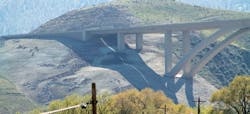About the author: Dori Larna, BS, LEED AP, is creative director for Hamilton Mfg. Inc. Larna can be reached at 208.733.9689.
Northern Nevada is home to one of the most expansive and expensive highway projects in history. Since 1983, the Nevada Department of Transportation, in conjunction with the Federal Highway Administration, commissioned the construction of Interstate 580. This project allowed interstate connection between Reno and Carson City, the state’s capital—until recently, one of the few capitals in the nation not connected to surrounding areas by an interstate. Clocking in at an approximate $575 million to complete, 90% of the funds were procured from federal and state gas tax money.
New Highway
The fragmented freeway was christened I-580 in the 1960s, but was known simply as U.S. 395 until completion last August. After decades of planning and executing several phases of construction, the most recently completed phase of construction between Mt. Rose Highway and the Bowers Mansion cutoff was deemed ready for travel in August 2012. The I-580/U.S. 395 project as a whole stretches 31 miles from Interstate 80 at the Spaghetti Bowl south to Fairview Drive in Carson City.
The new portion of the interstate that bypasses what is now known as the alternate U.S. 395 will take an approximate eight minutes off the commute between Carson City and Reno and is said to see upwards of 25,000 vehicles per day. Additional benefits will include a decrease in traffic congestion, improvement in traveler safety, accommodation of increasing traffic, reduction of vehicle emissions and beautification of the corridor.
Of these benefits, safety is the biggest concern. Studies show that over the course of 12 years, an average of 40,000 vehicles traveled the old highway every day, resulting in 1,610 accidents—including 33 fatalities and 521 in which a passenger was injured. Projections suggest that approximately 75% of travelers will use the new six-lane highway, inherently increasing safety on both roads.
Erosion Issues
The new stretch of the interstate crosses nine bridges that span canyons in the mountains overlooking Pleasant Valley—a vast difference from the old access road that ran through the valley floor. The Galena Creek Bridge is a six-lane-wide concrete cathedral-arch bridge, the largest of its kind in the world. It stands 300 ft above the ravine, spans 68 ft over Galena Creek, has an overall length of 1,722 ft and took nearly 10 years to complete. The construction of this phase of the highway, which included the Galena Creek Bridge, necessitated moving more than 3 million cu meters of earth, leaving behind soil that was highly susceptible to wind and water erosion.
Nestled on the eastern edge of the Sierra Nevada just four miles west of Galena Creek Park, this area consistently receives high winds and at least 18 in. of precipitation per year, much of which is released down Galena Creek during the spring runoff. Many homes are located at the base of the mountains, and dust control during construction and erosion control post construction was of top priority for the safety and air quality of homeowners and travelers.
Soil-Tech, an environmental restoration company based in Las Vegas, was chosen as a partner during all stages of construction of the I-580/U.S. 395 expansion. Its Reno division was contracted to hydroseed approximately 276 acres of excavated slopes and construction zones during construction. The hydroseeding slurry was composed of NaturesOwn High Density paper mulch, NaturesOwn Triple Tac guar-based tackifier, a seed mix and mycorrhizae (a soil inoculant). The crew mixed and applied the slurry using two different hydroseeders with 3,000- and 3,600-gal working capacities and the capability to discharge up to 230 ft. A great deal of the area contracted to hydroseed was inaccessible by truck. The crew did some intricate hose work to complete the project and was pleased to find that there was little to no clogging, even when stretching long distances. “This was a long-term project, but [the hydroseeding] ran smoothly and the outcome is successful so far,” said Vance Weems, production manager for Soil-Tech.
It was determined early in the design phase that simply adding vegetation to some of the steeper, longer cut slopes would not be sufficient, because the arid climate does not allow for ample vegetation to grow in the time necessary to stabilize the slopes. The design team decided on riprap topsoil hydroseeding to further stabilize the soil, and to use rock that was blown out to make way for the freeway, eliminating the need to haul it away. “The advantage of this method is that rainwater collects in the soil pockets, which form a sort of rainwater harvester, and the plants thrive in those soil pockets,” said Barbara Santner, RLA, AICP, senior landscape architect for Stantec.
To add vegetation to these pockets, Soil-Tech applied the mulch slurry at 2,000 lb per acre in two passes to allow desert species such as sagebrush and rabbitbrush to sit near the surface of the application, allowing ultraviolet rays to penetrate and expedite germination. The overall seed mixture was made up of 15 arid-climate-specific seeds including antelope bitterbrush, blue flax, ryegrass, wild rye and balsamroot.
In addition to the hydroseeding, Soil-Tech also was contracted to mitigate the color of the rock with its Permeon color mitigation system, a chemical process that increases the rate of the natural oxidation of the rock to achieve a consistency of color with the natural rock that was used during the riprap topsoil hydroseeding. “The reason we did some rock staining is because the native rock that’s out there has a natural patina that developed over thousands of years,” Santner said. “When you unearth rock, it’s lighter on the underside.”
The new stretch of freeway was a challenge to complete, but for the safety of travelers, it was essential for northern Nevada. Thanks to the teams of engineers and contractors, the safety factor will be exponentially increased through effective and innovative erosion control.
Download: Here


